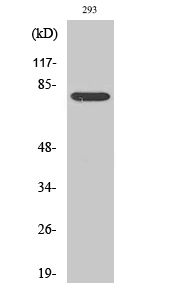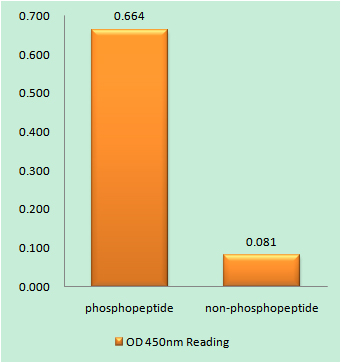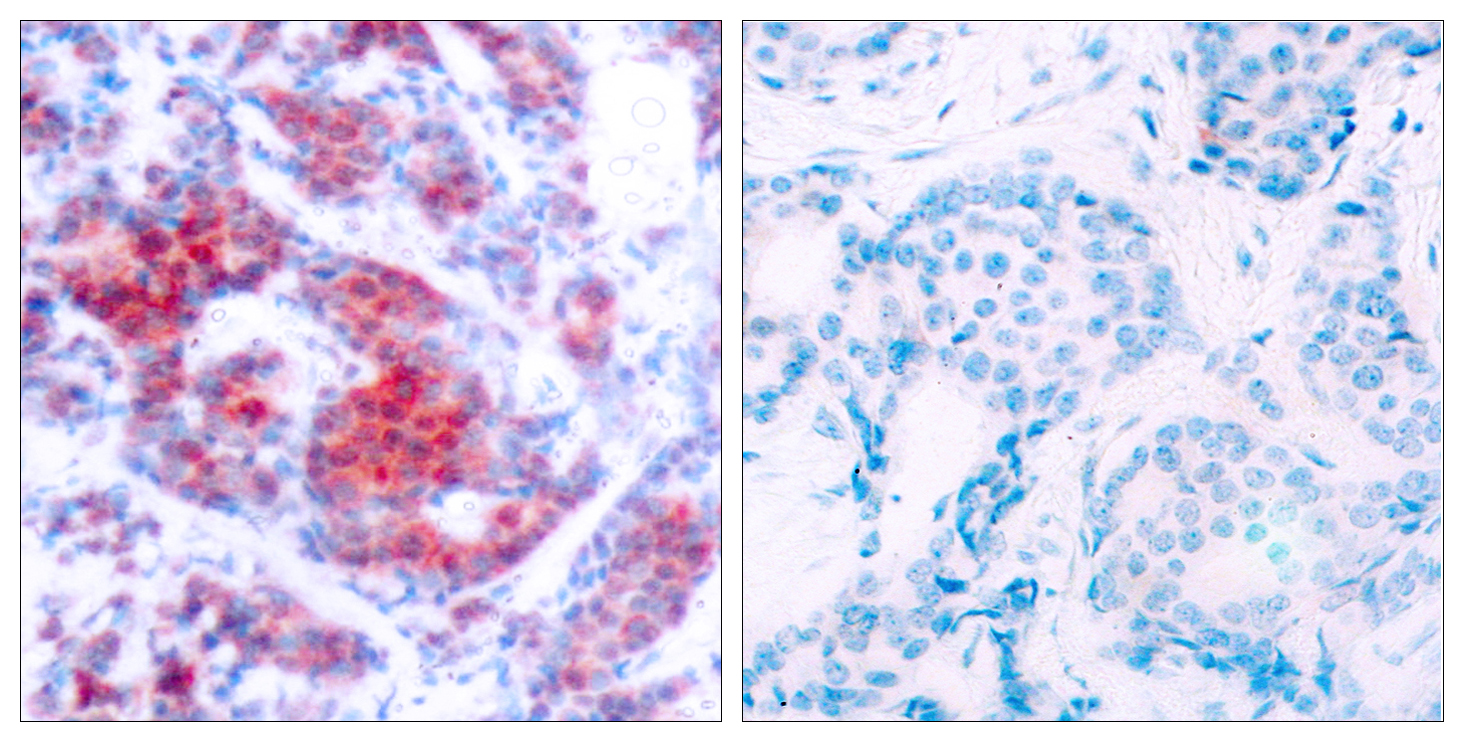
Catalog: YP1857
Size
Price
Status
Qty.
200μL
$936.00
In stock
0
100μL
$560.00
In stock
0
50μL
$300.00
In stock
0
Add to cart


Collected


Collect
Main Information
Target
Stat4
Host Species
Rabbit
Reactivity
Human, Mouse
Applications
IHC, WB
MW
86kD (Observed)
Conjugate/Modification
Phospho
Detailed Information
Recommended Dilution Ratio
WB 1:500-2000; IHC 1:50-200
Formulation
Liquid in PBS containing 50% glycerol, and 0.02% sodium azide.
Specificity
This antibody detects endogenous levels of STAT4 (Phospho Ser721) Rabbit pAb at Human, Mouse.The name of modified sites may be influenced by many factors, such as species (the modified site was not originally found in human samples) and the change of protein sequence (the previous protein sequence is incomplete, and the protein sequence may be prolonged with the development of protein sequencing technology). When naming, we will use the "numbers" in historical reference to keep the sites consistent with the reports. The antibody binds to the following modification sequence (lowercase letters are modification sites):PMsPS
Purification
The antibody was affinity-purified from rabbit serum by affinity-chromatography using specific immunogen.
Storage
-15°C to -25°C/1 year(Do not lower than -25°C)
Concentration
1 mg/ml
MW(Observed)
86kD
Modification
Phospho
Clonality
Polyclonal
Related Products
Antigen&Target Information
Immunogen:
Synthesized peptide derived from human STAT4 (Phospho Ser721)
show all
Specificity:
This antibody detects endogenous levels of STAT4 (Phospho Ser721) Rabbit pAb at Human, Mouse.The name of modified sites may be influenced by many factors, such as species (the modified site was not originally found in human samples) and the change of protein sequence (the previous protein sequence is incomplete, and the protein sequence may be prolonged with the development of protein sequencing technology). When naming, we will use the "numbers" in historical reference to keep the sites consistent with the reports. The antibody binds to the following modification sequence (lowercase letters are modification sites):PMsPS
show all
Gene Name:
STAT4
show all
Protein Name:
Signal transducer and activator of transcription 4
show all
Other Name:
Signal transducer and activator of transcription 4
show all
Background:
signal transducer and activator of transcription 4(STAT4) Homo sapiens The protein encoded by this gene is a member of the STAT family of transcription factors. In response to cytokines and growth factors, STAT family members are phosphorylated by the receptor associated kinases, and then form homo- or heterodimers that translocate to the cell nucleus where they act as transcription activators. This protein is essential for mediating responses to IL12 in lymphocytes, and regulating the differentiation of T helper cells. Mutations in this gene may be associated with systemic lupus erythematosus and rheumatoid arthritis. Alternate splicing results in multiple transcript variants that encode the same protein. [provided by RefSeq, Aug 2011],
show all
Function:
Disease:Genetic variations in STAT4 are associated with susceptibility to rheumatoid arthritis (RA) [MIM:180300]. Rheumatoid arthritis is a complex, multifactorial disorder. It is one of the most common autoimmune diseases and it is characterized by inflammation of synovial tissue and joint destruction.,Disease:Genetic variations in STAT4 are associated with susceptibility to systemic lupus erythematosus type 11 (SLEB11) [MIM:612253]. Systemic lupus erythematosus (SLE) is a chronic autoimmune disease with a complex genetic basis. SLE is an inflammatory, and often febrile multisystemic disorder of connective tissue characterized principally by involvement of the skin, joints, kidneys, and serosal membranes. It is thought to represent a failure of the regulatory mechanisms of the autoimmune system.,Function:Carries out a dual Function: signal transduction and activation of transcription. Involved in IL12 signaling.,PTM:Tyrosine phosphorylated. Serine phosphorylation is also required for maximal transcriptional activity.,similarity:Belongs to the transcription factor STAT family.,similarity:Contains 1 SH2 domain.,subcellular location:Translocated into the nucleus in response to phosphorylation.,subunit:Forms a homodimer or a heterodimer with a related family member (By similarity). The SH2 domain interacts, in vitro, with IL12RB2 via a short cytoplasmic domain.,
show all
Cellular Localization:
Cytoplasm. Nucleus. Translocated into the nucleus in response to phosphorylation.
show all
Research Areas:
>>Necroptosis ;
>>JAK-STAT signaling pathway ;
>>Th1 and Th2 cell differentiation ;
>>Hepatitis B ;
>>Pathways in cancer ;
>>Inflammatory bowel disease
>>JAK-STAT signaling pathway ;
>>Th1 and Th2 cell differentiation ;
>>Hepatitis B ;
>>Pathways in cancer ;
>>Inflammatory bowel disease
show all
Signaling Pathway
Cellular Processes >> Cell growth and death >> Necroptosis
Organismal Systems >> Immune system >> Th1 and Th2 cell differentiation
Human Diseases >> Cancer: overview >> Pathways in cancer
Human Diseases >> Immune disease >> Inflammatory bowel disease
Environmental Information Processing >> Signal transduction >> JAK-STAT signaling pathway
Reference Citation({{totalcount}})
Catalog: YP1857
Size
Price
Status
Qty.
200μL
$936.00
In stock
0
100μL
$560.00
In stock
0
50μL
$300.00
In stock
0
Add to cart


Collected


Collect
Recently Viewed Products
Clear allPRODUCTS
CUSTOMIZED
ABOUT US
Toggle night Mode
{{pinfoXq.title || ''}}
Catalog: {{pinfoXq.catalog || ''}}
Filter:
All
{{item.name}}
{{pinfo.title}}
-{{pinfo.catalog}}
Main Information
Target
{{pinfo.target}}
Reactivity
{{pinfo.react}}
Applications
{{pinfo.applicat}}
Conjugate/Modification
{{pinfo.coupling}}/{{pinfo.modific}}
MW (kDa)
{{pinfo.mwcalc}}
Host Species
{{pinfo.hostspec}}
Isotype
{{pinfo.isotype}}
Product {{index}}/{{pcount}}
Prev
Next
{{pvTitle}}
Scroll wheel zooms the picture
{{pvDescr}}



















